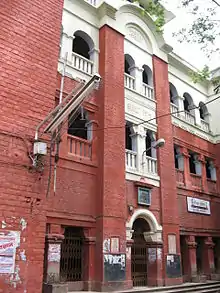Oriental Seminary
The Oriental Seminary started in 1829 by the educator Gour Mohan Addy, was the earliest privately run, first-rate school for children of Hindu parents in Kolkata (then known as Calcutta). It was open only to boys of Hindu parents.[1] It was possibly India’s first fully private school, as even Hindu School, then known as Hindu College, and also Hare school had to abide by certain government guidelines.[2] In earlier days, students wanting to study English had to go to the missionary schools, where they were subject to substantial religious influence. The establishment of a school for learning English, free from religious influences was a major contribution of Addy.[3] Traditional Indian education centres which taught Sanskrit and/or Persian had started fading out.

The school
The school was first located at Benshohata. Thereafter, it shifted its location thrice before moving into the present building on Rabindra Sarani (earlier known as Chitpur Road) in Jorasanko, often wrongly referred to as Chitpur. It was inaugurated by the governor of Bengal, Lord Carmichael, in 1914. Its monthly fee of Rs 3 compared to Hindu School's Rs. 5 helped it to draw more students.[2]
In 1836, a morning session for the infants was started. Bengali was introduced as a medium of instruction in 1839. By popular demand, three branches of the institution were set up in Chitpur, Bhowanipur and Belghoria. The school opened a girls' section in 1934. The higher secondary section of the school became co-educational in 1991. The building, constructed by Martin Burn, was declared a heritage structure in 1999.[2]
The first president of Indian National Congress, barrister W.C.Bonnerjee was an ex-student and the first president of the governing body of the school till his death in 1906. He was succeeded by Sir Ashutosh Mukherjee who was associated with the school as the president of its governing body from 1907 to 1922. Annie Besant was the president of the annual function of the school in 1926.[4]
The founder and teachers
Gour Mohan Addy (20 January 1805 – 3 March 1846) started the school without any support from the government. For the junior classes, he appointed Eurasians, in the intermediate classes he had Bengali teachers and for the upper classes he appointed highly qualified Englishmen or Bengalis. He died in a boat accident in the Hooghly river, when returning from Serampore, after searching for a teacher for his school.[3]
Shakespearean scholar Captain D.L. Richardson taught English in the school.[2]
Currently the principal of the primary section is Rina Basak Halder
Notable alumni
Oriental Seminary was the earliest school Rabindranath Tagore attended.[5] The first experience of school aroused in the youngster the yearning to be a teacher. Wielding a stick, he used to teach from the railings in the big veranda of the palatial Jorasanko Thakur Bari.[6][7][8]
Among the list of other notable alumni are Bhaktisiddhanta Sarasvati,[9] Krishnadas Pal, Girish Chandra Ghosh, Womesh Chandra Bonnerjee, Sir Gooroodas Banerjee, Sambhunath Pandit, Vishwanath Datta, Amrita Lal Basu, Akshay Kumar Datta, Sudhindranath Dutta,[10] Jatindranath Sengupta, Swami Abhedananda, Bankim Ghosh, Malay Roy Choudhury and Mithun Chakraborty.[3][11][12]
References
- Kopf, David, The Brahmo Samaj and the Shaping of the Modern Indian Mind, p. 49, Princeton University Press.
- Roy, Subhajoy (13 January 2006). "Pages from past lessons". Calcutta, India: The Telegraph, 13 January 2006. Retrieved 4 May 2007.
- Sengupta, Subodh Chandra and Bose, Anjali (editors), 1976/1998, Sansad Bangali Charitabhidhan (Biographical dictionary) Vol I, (in Bengali), p. 147, ISBN 81-85626-65-0
- "Buddha woe over English". Calcutta, India: The Telegraph, 20 February 2005. 20 February 2005. Retrieved 4 May 2007.
- Life of Rabindranath Tagore at a glance
- Banerjee, Hiranmay, Thakurbarir Katha, (in Bengali), p. 124, Sishu Sahitya Sansad]
- Ghose, Chandreyee (7 May 2015). "Treasure trove at Tagore's school". Telegraph. India. Retrieved 17 May 2018.
- Sardella, Ferdinando (2013a). Modern Hindu Personalism: The History, Life, and Thought of Bhaktisiddhanta Sarasvati (reprint ed.). New York, NY: Oxford University Press. p. 64. ISBN 978-0199865901.
- Sudhindranath: the Person I Knew
- Seedhi Baat -- Mithun Chakraborty